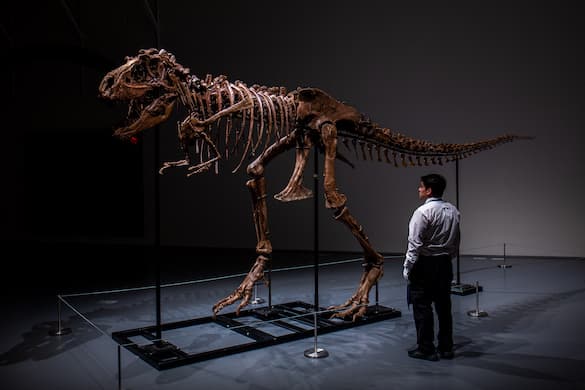‘Jurassic Park Avenue’ — Guess What’s Coming to Life on the Upper East Side
Gorgosaurus, older cousin of Tyrannosaurus Rex, was ‘faster and fiercer’ and ‘the master hunter of its time.’ Just the right gift for your favorite hedge fund billionaire.

To paraphrase one of Jurassic Park’s iconic lines, “Life, or Sotheby’s, finds a way.” That truism will be reaffirmed on the Upper East Side this month, as a Gorgosaurus skeleton makes its auction debut. The apex predator, which comes in at 10 feet tall and 22 feet long, is expected to fetch between $5 million and $8 million, according to the auction house’s prognosticators.
Check it out, we say.
The Gorgosaurus, whose name means “fierce lizard,” has taken the long road to the auctioneer’s lot. It appeared on the planetary scene during the Late Cretaceous period, approximately 77 million years ago. This Gorgosaurus was unearthed in what is now Montana in 2018, and is the only one who now roams outside of an institutional collection.
Gorgosaurus was older than its cousin the Tyrannosaurus Rex by about 10 million years. While slightly smaller, Sotheby’s notes that it was “faster and fiercer,” “the master hunter of its time,” and “a dominant force and a singular predator.” In 2012, an article in the Open Geology Journal tallied Gorgosaurus’s bite strength at 42,000 newtons, stronger than any creature living today.
Sotheby’s global head of science and popular culture, Cassandra Hatton, marvels that she has “had the privilege of handling and selling many exceptional and unique objects, but few have the capacity to inspire wonder and capture imaginations quite like this unbelievable Gorgosaurus skeleton.”
Gorgosaurus follows in illustrious footsteps. In 1997, Sotheby’s sold the first ever dinosaur fossil offered at auction — a complete T-Rex given the appellation “Sue” — for more than $8 million. In 2020, “Stan,” another T-Rex, sold at Christie’s for just shy of $32 million.
According to American law, fossils found on private land belong to those who own title to the property, while those found on federal land are subject to regulation under the Paleontological Resources Preservation Act.
The Society of Vertebrate Paleontology, which aims to “advance the science of vertebrate paleontology throughout the world,” opposes auctioning off fossils. It noted in a letter to Christie’s before Sue was sold: “Scientifically important vertebrate fossils are part of our collective natural heritage and deserve to be held in public trust.”
The Gorgosaurus will headline the Sotheby’s “Natural History” auction slate on July 28. Its appearance comes as the latest installment in the Jurassic Park franchise, “Dominion,” roars past $800 million at the global box office, demonstrating that interest in these ancient beasts is anything but extinct.

